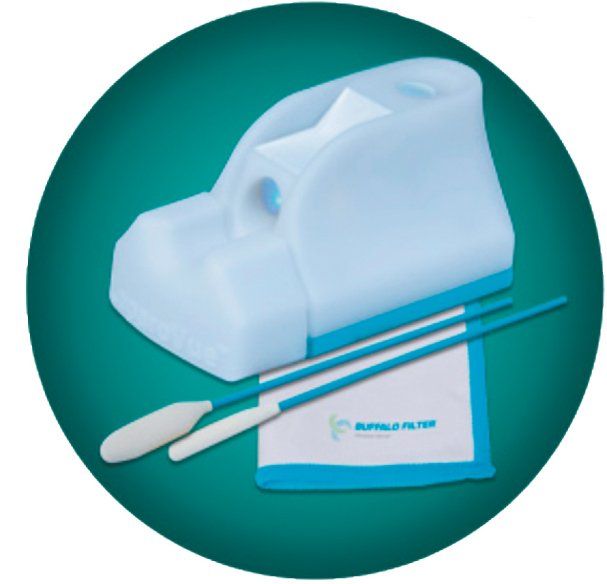LaparoVue Visibility System
James Greenberg, MD, reviews the LaparoVue Visibility System, a single-use, disposable system designed to eliminate fogging while cleaning laparoscopes and trocars during a procedure.


Background
I am as tormented by suboptimal laparoscopic views as I am about greasy fingerprints on my glasses and it is with this hate-inspired passion that I evaluated Buffalo Filter’s LaparoVue® Visibility System.
Design/Functionality
The LaparoVue® Visibility System is a single-use, disposable system designed to eliminate fogging while cleaning laparoscopes and trocars during a procedure. The system is actually three-fold: a hub with warming and cleaning ports, 2 VueTipTM trocar swabs and a microfiber cleaning cloth. The meat of the system is a molded silicone, battery-powered box with 2 ports (1 for warming and white balancing, 1 for cleaning and defogging) and a detachable scope cradle. The battery provides the energy for both the warming unit and projecting LED light that accentuates the ports. The base of the hub is detachable to cradle the scope horizontally while it is being warmed. Both ports have flexible seals that accommodate scopes from 3 mm to 12 mm without an adapter. The 2 VueTipTM trocar swabs are plunger-like, radiopaque swabs designed to fit into 5-mm and 12-mm trocars. Finally, the microfiber cleaning cloth is…a microfiber cleaning cloth.

In testing in the OR, the LaparoVue® Visibility System was excellent. Mindlessly easy to use, it kept my laparoscopes defogged and smudge-free and provided a good platform on which to rest the scopes while they were not in use. In short, it did exactly what it was supposed to do and did it very well.
Innovation
As much as I liked LaparoVue®, it is hard to give the engineers at Buffalo Filter too much ingenuity credit since this system is simply an improved D-HELP (now, ClearifyTM from Medtronic, LLC). With regard to the improvements, Buffalo Filter did a nice job fine-tuning this product but the real innovation points still have to go to the D-HELP peeps for coming up with the original idea.
Value
I am somewhat biased against single-use devices. Their cost never goes down with amortization and creating more medical waste landfill is not a good idea. However, there is little point in spending a fortune on an expensive laparoscopy system only to have condensation and drops of blood and fat blur your 4K picture. For small cases, the LaparoVue® is probably not worth it. But, for more complex procedures it seems like short money.
Summary
Consistent, high-quality imaging is essential for laparoscopic procedures. As optical technology evolves, advances in both resolution and lighting will likely offer future surgeons pictures that will make current technology seem like black and white TV. Regardless of how it’s done, each OR team needs an efficient system to keep their scopes clean. For quick cases, a moist sponge is probably fine. For longer, more complex cases, the LaparoVue® is worth trying.
The views of the author are personal opinions and do not necessarily represent the views of Contemporary Ob/Gyn.
Disclosure: The author reports no conflicts of interest with regard to the content of this review.
A Legacy of Excellence: Reflecting on the Final Print Edition of Contemporary OB/GYN
April 25th 2025Marking the end of an era and the beginning of a new chapter, the final print edition of Contemporary OB/GYN celebrates over 50 years of evidence-based guidance and unwavering support for clinicians.
Read More
